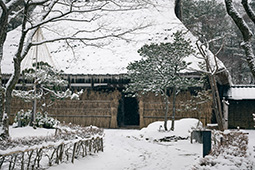INDEX
- English
- 日本語

A demonstration of Aenokoto at Gorokuan. Here, the head of the house, wearing formal attire, speaks to the deities - English
- 日本語

An Aenokoto meal

The deities of the rice fields are invited to bathe in a barrel 
Visitors can experience Aenokoto year-round at Gorokuan in Yanagida Botanical Park, Noto
November 2020
Showing Hospitality to the Rice-Field Deities

In the Oku Noto region of Ishikawa Prefecture, an agricultural ritual in which farming families show hospitality to the deities of the rice fields has been passed down for over 200 years.

In Oku Noto, a rice-producing region, an agricultural ritual known as Oku-noto no Aenokoto has been handed down by farming families for many years and has been inscribed on UNESCO’s Representative List of the Intangible Cultural Heritage of Humanity. The “Ae” of Aenokoto means “hospitality through food” and “koto” means “ritual.”
Aenokoto is a rite in which farming families show hospitality to the deities of the rice fields, and it is performed every year on December 5 and February 9. In December, farmers give thanks for the year’s harvest by inviting the deities of the rice fields into their homes, and in February, before planting, they pray to the deities for an abundant harvest and show them back out to the rice fields.
What makes this custom unique is that the head of the house, wearing formal robes, performs the ritual while speaking politely as if the deities were actually present.
The ritual in December begins with the head of the house going into the rice fields carrying in one hand a sacred sprig of a young evergreen tree and, in the other, a hoe. The farmer ceremonially tills the soil with the hoe three times then leads the deities back to his house. The deities are considered to be a married couple, and as both are said to have poor eyesight, the head of the house deferentially guides them and talks to them politely. For example, if there are steps in their path, he says, “There are some steps. Please step carefully.”

When they reach the house, the farmer invites the deities to rest by the hearth. While they are resting, he checks the temperature of the bath, and when the water is deemed hot enough, he invites the deities to bathe. After that, he guides them to the sitting room and describes the feast of rice, black rockfish, vegetables and other produce laid out before them. The head of the house expresses gratitude to the deities for the harvest of the ingredients. After the meal, the deities retire to a space where stacked rice bales have been ceremonially placed, and they stay there until February. In February, a similar ritual is performed, in which the deities are shown back out to the fields.
It is not clear when these rituals were established, but we know that they have continued for at least 200 years, as tableware for Aenokoto has been found inscribed with a date from the second half of the eighteenth century. During the Edo period (1603–1867), when there were no modern agricultural technologies, farmers faced many difficulties in producing rice, including weather disasters and pests. As Oku Noto is located between the mountains and the sea and has few open plains, rice is cultivated in small terraced fields carved out of the mountains, requiring a great deal of effort. It is thought that the ritual of paying respects to the deities of the rice fields, symbolic of nature itself, began as a means of overcoming these challenges.
Takeuchi Tsuyoshi, a representative of the Noto Mirai Sozo Network (Network in Noto for Future Design), says of Aenokoto, “It is fundamentally a conveyance of gratitude for the deities of the fields for the harvest of this year and a prayer for the next good harvest.”

The Noto Mirai Sozo Network was established with the goal of promoting the revitalization of the Noto region, and it manages Gorokuan, a thatched-roof house in the Yanagida Botanical Park where visitors can watch Aenokoto at any time of year.
Takeuchi says, “All of the dishes presented in the ritual are offered in generous portions. On top of that, two servings are prepared as the deities are a couple. After the ritual, the food is eaten by the family members.”
However, there are fewer and fewer farmers each year left to pass on the custom of Aenokoto. Tashiro Nobuo, from the Local Promotion Division at Noto Town Hall, says, “Currently, there are about eighty farmers who perform Aenokoto. Simplification of the ritual slowly continues and there may only be ten farmers remaining who perform the ritual in the formal attire. I hope visitors learn how local people relate to nature by watching the ritual at Gorokuan.”
This rare ritual of showing hospitality to the deities of the rice fields is a part of Japanese farming culture. Local people continue to work together to preserve and pass on this unique folk tradition.

